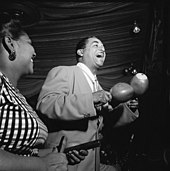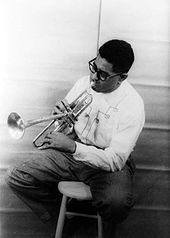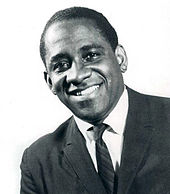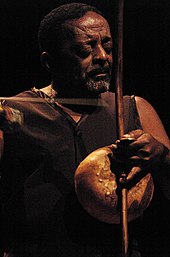Latin jazz
| Latin jazz | |
|---|---|
| Stylistic origins | Afro-Cuban jazz:
|
| Cultural origins | Cuba; New York City, United States; and Brazil |
| Regional scenes | |
| |
Latin jazz is a genre of jazz with Latin American rhythms. The two main categories are Afro-Cuban jazz, rhythmically based on Cuban popular dance music, with a rhythm section employing ostinato patterns or a clave, and Afro-Brazilian jazz, which includes samba and bossa nova.
Afro-Cuban jazz
"Spanish tinge"—The Cuban influence in early jazz and proto-Latin jazz


"
Now in one of my earliest tunes, "New Orleans Blues," you can notice the Spanish tinge. In fact, if you can't manage to put tinges of Spanish in your tunes, you will never be able to get the right seasoning, I call it, for jazz—Morton (1938: Library of Congress Recording).[8]

Although the exact origins of jazz syncopation may never be known, there is evidence that the habanera-tresillo was there at its conception. Buddy Bolden, the first known jazz musician, is credited with creating the big four, a habanera-based pattern. The big four (below) was the first syncopated bass drum pattern to deviate from the standard on-the-beat march.[9] As the example below shows, the second half of the big four pattern is the habanera rhythm.

It is probably safe to say that by and large the simpler African rhythmic patterns survived in jazz ... because they could be adapted more readily to European rhythmic conceptions. Some survived, others were discarded as the Europeanization progressed. It may also account for the fact that patterns such as [tresillo have] . . . remained one of the most useful and common syncopated patterns in jazz—Schuller (1968).[10]
The Cuban influence is evident in many pre-1940s jazz tunes, but rhythmically, they are all based on single-celled motifs such as
Jazz in-clave

The first
The right hand of the "Tanga" piano guajeo is in the style known as ponchando, a type of non-arpeggiated guajeo using block chords. The sequence of attack-points is emphasized, rather than a sequence of different pitches. As a form of accompaniment it can be played in a strictly repetitive fashion or as a varied motif akin to jazz comping.[11] The following example is in the style of a 1949 recording by Machito. 2‐3 clave, piano by René Hernández.[12]

The first descarga that made the world take notice is traced to a
Mario Bauza, Machito's trumpeter and music director, heard pianist Luis Varona and bassist Julio Andino play El Botellero composition and arrangements of the Cuban-born Gilberto Valdez which would serve as a permanent sign off (end the dance) tune.On this Monday evening, Dr. Bauza leaned over the piano and instructed Varona to play the same piano vamp he did the night before. Varona's left hand began the introduction of Gilberto Valdes' El Botellero. Bauza then instructed Julio Andino what to play; then the saxes; then the trumpets. The broken chord sounds soon began to take shape into an Afro-Cuban jazzed up melody. Gene Johnson's alto sax then emitted oriental-like jazz phrases. Afro-Cuban jazz was invented when Bauza composed "Tanga" (African word for marijuana) that evening of 1943.
Thereafter, whenever "Tanga" was played, it sounded different, depending on a soloist's individuality. In August 1948, when trumpeter Howard McGhee soloed with Machito's orchestra at the Apollo Theatre, his ad-libs to "Tanga" resulted in "Cu-Bop City," a tune which was recorded by Roost Records months later. The jams which took place at the Royal Roots, Bop City and Birdland between 1948 and 1949, when Howard McGhee, tenor saxophonist Brew Moore, Charlie Parker and Dizzy Gillespie sat in with the Machito orchestra, were unrehearsed, uninhibited, unheard-of-before jam sessions which at the time, master of ceremonies Symphony Sid called Afro-Cuban jazz.
The Machito orchestra's ten- or fifteen-minute jams were the first in Latin music to break away from the traditional under-four-minute recordings. In February 1949, the Machito orchestra became the first to set a precedent in Latin music when it featured tenor saxophonist Flip Phillips in a five-minute recording of "Tanga." The twelve-inch 78 RPM, part of The Jazz Scene album, sold for $25—Salazar (1997).[13]

Mario Bauzá developed the 3-2 / 2-3 clave concept and terminology. A chord progression can begin on either side of clave. When the progression begins on the three-side, the song or song section is said to be in 3–2 clave. When the chord progression begins on the two-side, it is in 2–3 clave. In North America, salsa and Latin jazz charts commonly represent clave in two measures of cut-time (2/2); this is most likely the influence of jazz conventions.[14] When clave is written in two measures (above) changing from one clave sequence to the other is a matter of reversing the order of the measures.
Bobby Sanabria, who was Bauzá's drummer, cites several important innovations of Machito's band:
- The first band to explore jazz arranging techniques with authentic Afro-Cuban rhythms on a consistent basis giving it a unique identifiable sound that no other band in the genre of Afro-Cuban based dance music had at the time. Cuban big band arranger Chico O'Farill stated: "This was a new concept in interpreting Cuban music with as much (harmonic) richness as possible. You have to understand how important this was. It made every other band that came after, followers."[15]
- The first band to explore modal harmony (a concept explored much later by Miles Davis and Gil Evans) from a jazz arranging perspective through their recording of "Tanga." Of note is the sheet of sound effect in the arrangement through the use of multiple layering.
- The first big band to explore, from an Afro-Cuban rhythmic perspective, large-scale extended compositional works. e.g. "The Afro-Cuban Jazz Suite" by Chico O'Farill.
- The first band to successfully wed jazz big band arranging techniques within an original composition with jazz oriented soloists utilizing an authentic Afro-Cuban based rhythm section in a successful manner. e.g. Gene Johnson - alto, Brew Moore - tenor, composition - "Tanga" (1943).
- The first Afro-Cuban based dance band to overtly explore the concept of clave counterpoint from an arranging standpoint. The ability to weave seamlessly from one side of the clave to the other without breaking its rhythmic integrity within the structure of a musical arrangement.[16]

Bauzá introduced bebop innovator Dizzy Gillespie to the Cuban conga drummer Chano Pozo. "Manteca" is the first jazz standard to be rhythmically based on clave. "Manteca" was co-written by Dizzy Gillespie and Chano Pozo in 1947. According to Gillespie, Pozo created the layered, contrapuntal guajeos (Afro-Cuban ostinatos) of the A section and the introduction, and Gillespie wrote the bridge. The rhythm of the melody of the A section is identical to a common mambo bell pattern.

On March 31, 1946, Stan Kenton recorded "Machito," written by his collaborator / arranger Pete Rugolo, which is considered by some to be the first Latin jazz recording by American jazz musicians. The Kenton band was augmented by Ivan Lopez on bongos and Eugenio Reyes on maracas. Later, on December 6 the same year, Stan Kenton recorded an arrangement of the Afro-Cuban tune "The Peanut Vendor" with members of Machito's rhythm section. Kenny Dorham "Minor's Holiday", "Basheer's Dream",[17] Hank Mobley "Recado Bossa Nova" and Sabu Martinez jazz tune developed Afro-Cuban jazz from 50s to 60s.[18]

Cuban percussionist

Bossa nova
Bossa nova was developed in Brazil in the mid-1950s, with its creation being credited to artists including
The initial releases by Gilberto and the internationally popular 1959 film
The first bossa nova single to achieve international popularity was perhaps the most successful of all time, the 1964 Getz/Gilberto recording "
An early influence on bossa nova was the song "
The so-called "bossa nova clave" (or "Brazilian clave") is played on the snare rim of the drum kit in bossa nova. The pattern has a similar rhythm to that of the son clave, but the second note on the two-side is delayed by one pulse (subdivision). The pattern is shown below in 2/4, as it is written in Brazil. In North American charts it is more likely to be written in cut-time.

According to drummer
Beyond Latin jazz


Brazilian percussionist
Another innovative Brazilian percussionist is
While Vasconcelos uses Afro-Brazilian rhythms and instruments, he like Airto, transcend the categories of Brazilian jazz and Latin jazz.Comparing Latin jazz with straight-ahead jazz
In comparison with straight-ahead jazz, Latin jazz employs
Formats
Latin jazz music, like most types of jazz music, can be played in small or large groups. Small groups, or combos, often use the bebop format made popular in the 1950s in America, where the musicians play a standard melody, many of the musicians play an improvised solo, and then everyone plays the melody again. Prominent Latin jazz big bands include Arturo O'Farrill's Afro-Latin Jazz Orchestra, Bobby Sanabria's Multiverse Big Band, Raices Jazz Orchestra, Mambo Legends Orchestra, Pacific Mambo Orchestra, as well as others. In Latin jazz bands, percussion is often featured in solos. Contemporary Latin jazz pieces by musicians such as Hermeto Pascoal are mostly composed for these small groups, with percussion solos as well as many wind-instrumentals.[25]
Latin Jazz as Global Music
Most jazz histories emphasize the narrative that jazz is exclusively an American music—a style created by African Americans in the early 20th century, fusing elements of African rhythm and improvisations with European instrumentation, harmonies, and formal structures. The influences of musics from the Caribbean and Latin America—save
See also
- Calle 54 - a film about Latin jazz
- Grammy Award for Best Latin Jazz Album
- Latin Grammy Award for Best Latin Jazz/Jazz Album
References
- ^ Manuel, Peter (2009: 69). Creolizing Contradance in the Caribbean. Philadelphia: Temple University Press.
- ^ Acosta, Leonardo (2003: 5). Cubano Be Cubano Bop; One Hundred Years of Jazz in Cuba. Washington D.C.: Smithsonian Books.
- ISBN 0-9614701-9-4.
- ^ "Wynton Marsalis part 2." 60 Minutes. CBS News (26 June 2011).
- ISBN 959-10-0048-0.
- ^ Father of the Blues: An Autobiography. by W.C. Handy, edited by Arna Bontemps: foreword by Abbe Niles. Macmillan Company, New York; (1941) pages 99, 100. no ISBN in this first printing
- ^ Roberts, John Storm 1979. The Latin tinge: the impact of Latin American music on the United States. Oxford.
- ^ Morton, "Jelly Roll" (1938: Library of Congress Recording) The Complete Recordings By Alan Lomax.
- ^ Marsalis, Wynton (2000: DVD n.1). Jazz. PBS
- ^ Schuller, Gunther (1968: 19) Early Jazz; Its Roots and Musical Development. New York: Oxford Press.
- ISBN 1-886502-80-3.
- ISBN 144998018X
- ^ Salazar, Max (1997). "The Beginning and Its Best" Latin Beat Magazine v.7 n. 1.
- ISBN 0-9614701-9-4.
- ^ Notes from The Mambo Inn -The Story of Mario Bauza. PBS documentary (1998).
- ^ Bobby Sanabria, posting to the Latinjazz discussion list (2008). [1]
- ^ "Afro-Cuban - Kenny Dorham | Songs, Reviews, Credits | AllMusic". AllMusic.
- ^ "Hank Mobley discography".
- ^ "Afro Blue," Afro Roots (Mongo Santamaria) Prestige CD 24018-2 (1959).
- ISBN 1-886502-80-3.
- ^ Bobby Sanabria cited by Peñalosa (2009: 243). The Clave Matrix.
- ^ Allmusic Biography
- ^ Palmer, Robert (1982-06-28). "Jazz Festival - A Study Of Folk-Jazz Fusion - Nytimes.Com". The New York Times. Retrieved 2014-02-24.
- ^ Robert Palmer (1987-09-03). "Jazz: Don Cherry". The New York Times. Retrieved 2014-02-24.
- S2CID 217508944.
- ISBN 978-0135098851.
- OCLC 26850817.
- ^ Kelley, Robin. "Into the Mist: Thoughts on Ken Burns's Jazz". ISAM Newsletter. 30, no.2 (Spring 2001): 8–15.
- OCLC 40256200.
- OCLC 1125295202.
- OCLC 1125295202.
Bibliography
- Acosta, Leonardo (2003) One Hundred Years of Jazz in Cuba. Washington DC: Smithsonian Books.
- Campos Fonseca, Susan. "¿Una habitación propia en el "Jazz Latino"?". En: IASPM@Journal, Vol. 1, Nº2 (2010).
- Delannoy, Luc (2001) Caliente, una historia del Jazz Latino. Mexico: FCE.
- Delannoy, Luc (2005) Carambola, vidas en el Jazz Latino. Mexico: FCE.
- Delannoy, Luc (2012) Convergencias Mexico: FCE.
- Leymarie, Isabelle (1979). "Latin Jazz, the Best of Both Worlds". Jazz Spotlite News. New York.
{{cite book}}: CS1 maint: location missing publisher (link) - ISBN 0-688-02193-X.)
{{cite book}}: CS1 maint: location missing publisher (link - ISBN 2130453171.
- ISBN 2082108139.
- ISBN 2-07-053391-3.)
{{cite book}}: CS1 maint: location missing publisher (link - ISBN 84-460-0894-7.)
{{cite book}}: CS1 maint: location missing publisher (link - ISBN 2-906460-69-9.)
{{cite book}}: CS1 maint: location missing publisher (link - ISBN 2-7467-0118-9.)
{{cite book}}: CS1 maint: location missing publisher (link - ISBN 0826455867.
- Mauleón, Rebeca (1993). Salsa Guidebook for Piano and Ensemble. Petaluma, California: Sher Music. ISBN 0-9614701-9-4.
- Peñalosa, David (2009). The Clave Matrix; Afro-Cuban Rhythm: Its Principles and African Origins. Redway, CA: Bembe Inc. ISBN 1-886502-80-3.
- Roberts, John Storm (1999) Latin Jazz. New York: Schirmer Books.
- Wasaburne, Christopher.(2020) Latin Jazz: The Other Jazz, Oxford University Press.
External links
- Latin jazz at Curlie
